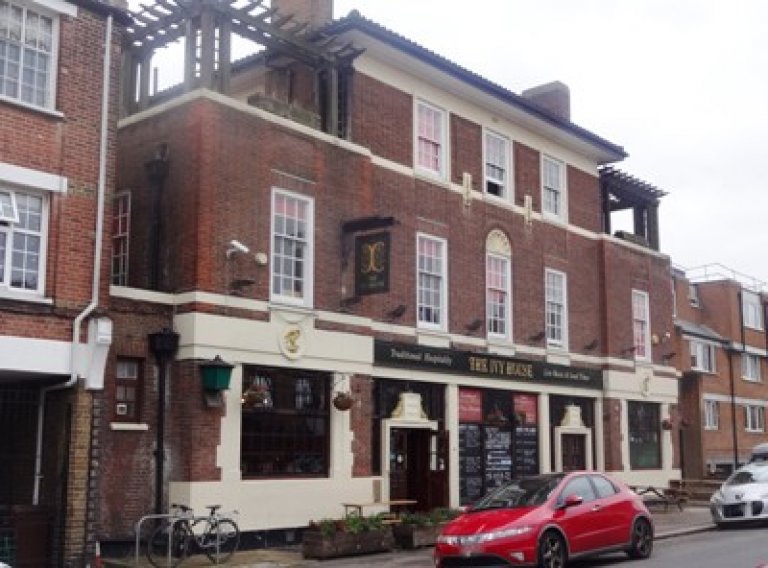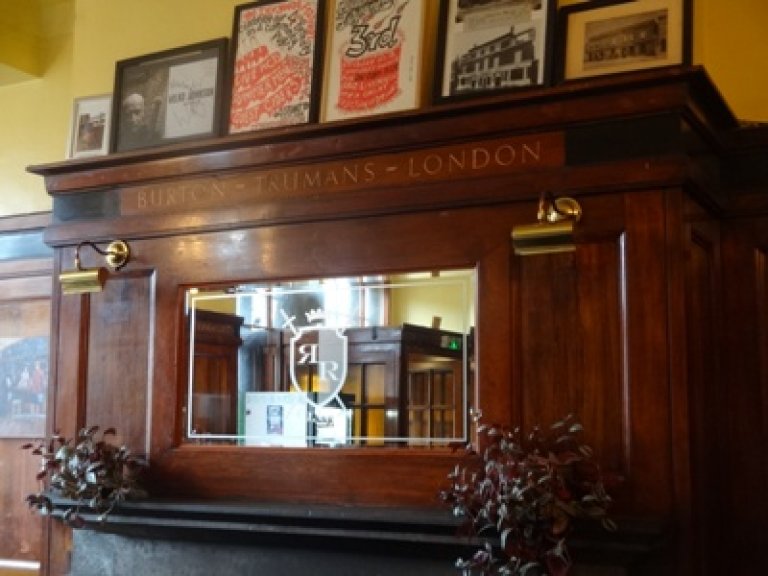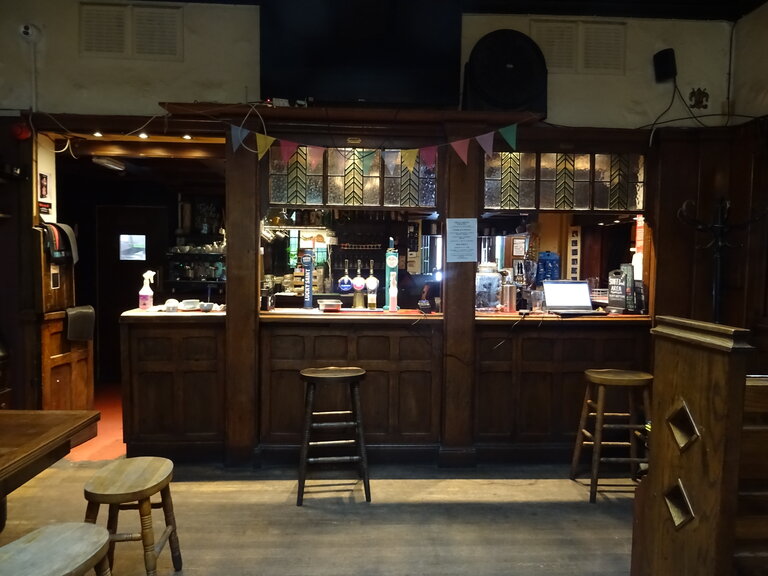Ivy House
40 Stuart RoadNunhead
SE15 3BE
This pub is not only a grade II listed building, it is also a Two Star pub on the Campaign for Real Ale’s (CAMRA) National Inventory with an interior of very special national historic interest, and the description is as follows: “The pub was the first in the country to be registered as an Asset of Community Value, was then acquired via the community right to buy provisions of the Localism Act, and re-opened in summer 2013. This pub has seen better, more prosperous days and this is reflected in the fact that the right-hand part has now been hived off for residential accommodation. It must have been truly enormous when originally built in the 1930s by Truman’s brewery. They have provided an unusual piece of architecture here – quite blocky with the central three bays rising to an extra floor above the side ones. The pub is still large with two epic rooms at the back. These have interestingly contrasted characters: that on the right has a Tudor look with an inglenook fireplace, panelled walls, Wood Look beams and cartouches on the walls with such would-be antique emblems as a visored knight, a portcullis, a swan and red roses. The other room has decidedly simple Art Deco details. The front room – small in comparison – was originally no doubt intended to be a smart one as is suggested by the elegant canopy over the bar counter. The counters throughout are original but the back fittings are largely modern. Other features to look out for are the brown and white spittoon trough tiling (a feature of many 1930s Truman’s pubs) and original tiling in the gents’.”
The listing description is as follows: “Public house. 1930s designed by AE Sewell for Truman's Brewery. Reasons for Designation The Ivy House, formerly the Newlands Tavern, 40 Stuart Road, Nunhead, a 1930s public house designed by AE Sewell is designated at Grade II for the following principal reasons: * Degree of survival: an unusually high level of surviving original features and fittings form a largely complete 1930s interior, now relatively rare, which illustrates the style, layout and features once typical of a suburban 'improved' pub; * Interior interest: wide range of good quality fittings on a consistent architectural theme including signage, fireplaces, bar counters and screens, tiled spittoon troughs, wooden panelling, coloured glazing, decorative plaster plaques, and hall with stage and Jacobethan style refreshment room; * Architectural interest: designed for a major brewery by a notable pub architect with a smart neo-Georgian frontage and idiosyncratic detailing. History The original pub on this site, the Newlands Tavern, was apparently built in the late 1870s or early 1880s and is first shown on the 2nd edition Ordnance Survey map from 1898. This was a two-storey building with a courtyard to the rear. In the 1930s, the owners, Truman, Hanbury, Buxton and Co, rebuilt the building, most likely to plans by their in-house architect AE Sewell who was responsible for numerous Truman’s pubs built or remodelled in the inter-war period. The lease the brewery signed with Edgar William Rhodes in 1922 expired in 1936 so it may be that the pub was rebuilt then. The pub was originally adjoined to the east by a parade of shops which was destroyed by a V1 flying-bomb in July 1944. During the ‘pub-rock’ boom of the mid-1970s, the Newlands Tavern was one of the major pub venues in South London and hosted early incarnations of many bands and performers who later rose to fame including Ian Dury, Elvis Costello, Joe Strummer and Dr Feelgood. The pub was later renamed the Stuart Arms before becoming The Ivy House. Details MATERIALS: mixed red and brown brick in Flemish bond with concrete or Portland Stone dressings with an overhanging, hipped tile roof to the central block and flat roofs with parapets to the wings. EXTERIOR: designed in a neo-Georgian style, the building has a symmetrical front elevation of five bays, consisting of a three bay, three-storey, central block flanked by slightly projecting single bay, two-storey wings. To the rear a single-storey range contains the rear bar/refreshment room and the hall. On the front elevation the upper floors have horned sash windows with glazing bars in square openings. The first-floor windows have gauged brick arches, except for the central window which is set in a taller semi-circular headed arch with scallop decoration in the tympanum. The lintels of the second-floor windows are formed by the continuous broad concrete cornice. The large windows in the end bays of the ground floor are treated differently with irregular quoins and broad heads bearing plaques with the Truman logo continuous with a broad platband. The pair of entrances adjoining these bays have timber frames topped by square plaques, supported by volutes and bearing carriage lamps, and are surrounded by glazed screens. The rear of the building with its assortment of flat roofs has a mixture of original sash windows and uPVC replacements. INTERIOR: consists of two front bars (the western bar has been converted to staff accommodation), the eastern bar giving access to a large hall to the rear. Adjoining this to the west is a rear bar which would originally have been a refreshment room. All three bars and the hall were served from a central service area and kitchen. The eastern front bar (originally the saloon bar) retains its dado height panelling, glazed entrance lobby, moulded stone fire surround, glazed multi-pane screen to the hall and original bench seating. The cornice of the panelling bears original incised gold lettering bearing the legends ‘BURTON – TRUMANS – LONDON’ over the fireplace, ‘BEN TRUMAN’ over the entrance to the men’s toilets, ‘IMPERIAL STOUT’,’ BURTON BREWED BITTER’ and ‘TRUBROWN ALE’ over the hall screen, and ‘TRUMANS EAGLE ALES’ near the front entrance). The curved bar counter is original and has the brown and white chequered tile spittoon trough which was a feature of 1930s Truman’s pubs. The panels over the bar counter are probably original but the bar back is modern. The men’s toilet retains its original white tiling. The large hall is also panelled to dado height and has a stage at the northern end. This appears to retain its proscenium arch beneath later stage dressings. The hall has an original stone fire surround, bar counter with chequered tile spittoon trough, glazed double entrance doors from the front bar and recessed double doors to the refreshment room with an Art Deco style surround. The refreshment room/rear bar is decorated in a Jacobethan style with a timbered ceiling and decorative painted plaster plaques, animals, birds and ships above dado height panelling. These bear a resemblance to the plaster decoration on the exterior of the Railway Hotel, Edgware by the same architect. The room has an inglenook in the west wall with a stone fire surround, built-in settles (one having lost its arm rest) and pair of windows with a coloured glass chevron design. The north wall has a large multi-pane arched window with some original coloured glass and an exit to the rear courtyard. The bar is original with a glazed screen above at either end, again with a chevron design in coloured glass. The western front bar has been converted to accommodation and partitioned, probably to enlarge the adjoining women’s toilet, with the consequent loss of the bar counter. To judge from the simple fireplace, this was originally the public bar and it retains some other original features such as the coloured glazing in the metal windows, cornice and picture rail but is otherwise altered. The upper floors were not inspected, but are understood to consist solely of modernized staff accommodation, and therefore unlikely to be of special interest. Selected Sources Books and journals Brandwood, G, Jephcote, J, London Heritage Pubs - An Inside Story, (2008), 49-50 Brandwood, G, Davison, A, Slaughter, M, Licensed To Sell: The History and Heritage of the Public House, (2011) 'South London Press' in Iconic Pub hit right note, (15 November 2011)”
The WhatPub link is here: WhatPub/Ivy House
The Pub Heritage Group link is here: PHG/Ivy House
The Ivy House featured on the Daytime Crawl of South East London on 16 June 2007, the The Beautiful South: Daytime Crawl of Outer South East London on 22 October 2011, and the Lunar Odyssey: From the Asylum to the Half Moon: Daytime Crawl of Peckham, Nunhead, Dulwich and Herne Hill ion 14 October 2017.
 Exterior
Exterior
 Public Bar
Public Bar
 Public Bar
Public Bar

 Former Refreshment Room
Former Refreshment Room
